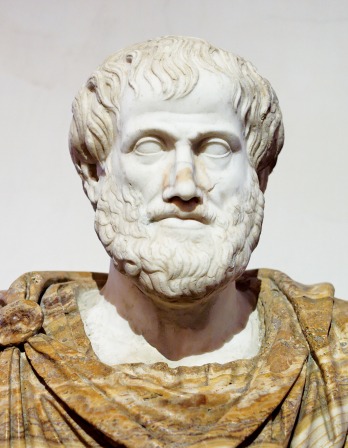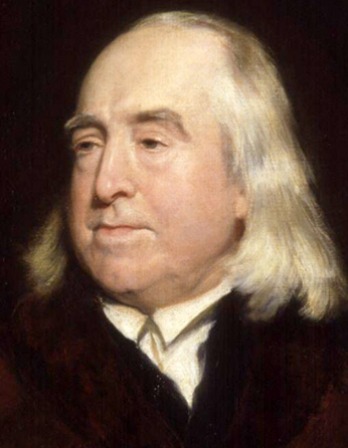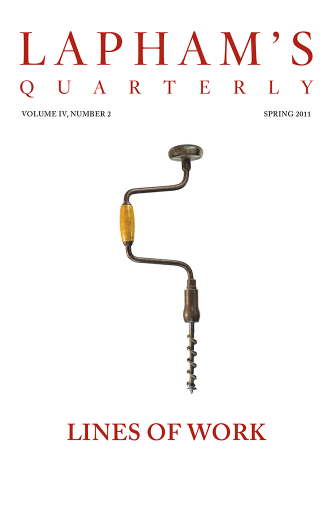Kingdom Come
The present is short and the future is doubtful—only the past is certain.
By Lewis H. Lapham

The Fortune Teller, by Georges de La Tour, c. 1630. The Metropolitan Museum of Art, Rogers Fund, 1960.
…Of comfort no man speak:
Let’s talk of graves, of worms, and epitaphs;
Make dust our paper, and with rainy eyes
Write sorrow on the bosom of the earth.
Let’s choose executors, and talk of wills…
For God’s sake, let us sit upon the ground,
And tell sad stories of the death of kings.—William Shakespeare, Richard II
Although I’ve yet to see sandwich-board men on the steps of the nation’s capitol declaring that the end of the world is nigh, I expect that it won’t be long before the Department of Homeland Security advises the country’s Chinese restaurants to embed the alert in the fortune cookies. President Obama appears before the congregations of the Democratic faithful as a man of sorrows acquainted with grief, cherishing the wounds of the American body politic as if they were the stigmata of the murdered Christ. The daily newscasts update the approaches of weird storms, bring reports of missing forests and lost polar bears, number the dead and dying in Africa and the Middle East, gauge the level of America’s fast-disappearing wealth. Hollywood stages nostalgic remakes of the Book of Revelation; video games mount the battle of Armageddon on the bosom of the iPad. Nor does any week pass by without a word of warning from the oracles at the Council on Foreign Relations, Fox News, and the New York Times. Their peerings into the abyss of what to the Washington politicians are known as “the out years” never fail to discover a soon forthcoming catastrophe (default on the national debt, double-dip recession, global warming, nuclear proliferation, war in Iran) deserving the close attention of their fellow travelers aboard the bus to Kingdom Come.
If the fear of the future is the story line that for the last ten years has made it easy to confuse the instruments of the American media with the trumpets of doom, the cloud of evil omens is not without a silver lining. The tears on King Richard’s dusty paper, like the handwriting on King Belshazzar’s fiery wall, protect the profit margins of the banks and the insurance companies, serve the interests of the drug and weapons industries, allow the season’s political candidates to clothe themselves in the raiment of a messiah come to cleanse the electorate of its impurities, take America back to where it belongs, risk-free and tax-exempt, in the little house on the prairie. Adapted to the service of the Church or the ambition of the state, the fear of the future is the blessing that extorts the payment of the protection money. For the Taliban and the Tea Party it’s a useful means of crowd control, but for a democratic republic, crouching in the shadow of what might happen tomorrow tends to restrict the freedom of thought as well as the freedoms of movement, and leads eventually to a death by drowning in the bathtub of self-pity.
By way of lifting the siege of dismal prophecy, this issue of Lapham’s Quarterly draws on the teaching of history to show the future as a land of make-believe, a work of the imagination, shaped by the emotion of the present and situated somewhere over the rainbow of a deconstructed past. Time flows upstream as well as down, which is the message brought to Oedipus by blind Tiresias and by Saint Augustine’s noticing that both past and future, “wherever they are, whatever they are,” exist nowhere else except in the minds of their beholders.
John Crowley completes the thought sixteen centuries further along the road to who knows where, finding that “the future, as always, is now,” a reflection in the mirror as opposed to a sighting in a crystal ball.
Triangulate the three geopolitical positionings, and it’s no wonder that the future is America’s most precious natural resource, the ground of its being and basis of its economy as well as the focus of its politics. It wasn’t always timid and small. Thomas Paine in January of 1776 welcomes the American Revolution as “the birthday of a new world,” the having it “in our power to begin the world over again,” to establish a government accommodating to the perfectibility of man. Paine was a child of the Enlightenment, which in its turn had derived the idea of progress from the seventeenth-century scientific revolution and the sixteenth-century humanism implicit in Thomas More’s projection of Utopia. The book appeared in 1516, the title coined from a compound Greek word meaning either “good place” or “no place.” Intending it in part as a satire on the debased and cynical society that was the glory of Tudor England, a mise-en-scène in which “money is the standard of all other things…and the best things will fall to the share of the worst men,” More also presented it as an earthly paradise other than the one pictured by the Catholic Church in the sweet hereafter on the far side of time. To shore up the strength of his secular argument, More conceived his island of Utopia as a virtual reality just over the horizon of history, crescent-shaped and fertile, emerging from the foam of a soon-to-be-charted sea, happily situated in the almost here and now as opposed to the Christian locations in the there and then. Drawing on his experience as chancellor to Henry VIII as well as from his reading of Plato’s Republic, More writes the first modern European prospectus for a commonwealth constructed to the design of human reason, its climate and topography formed by the Renaissance debate on the nature of a just society. What interests More is the common good, not the individual hope of salvation, and as a system of government he proposes a benign monarchy that condemns to slavery all present who commit the self-dealing crimes of passion and violence. Farmers freely exchange their corn and cattle for the manufactures of the town; gold and silver are used for the making of chamber pots.
Published during the middle years of the Age of Discovery, the book established a form of adventurous romance popular among freebooting ship captains embarked on voyages to Virginia, El Dorado, and Brazil. The literary device was soon adopted by philosophers searching for passages into new worlds of political thought. Over the course of the next three centuries, More’s fortunate kingdom comes to be variously situated in the writings of Thomas Hobbes and John Locke as well as in those of Baron de Montesquieu, Denis Diderot, Jean-Jacques Rousseau, and the Marquis de Condorcet. The philosophers reposition the lines of latitude and longitude in accordance with their theories of a social contract, and in Philadelphia in 1776 the virtual reality that More in 1516 had placed somewhere off the coast of the newly discovered Americas emerges from the play of mind that is the Declaration of Independence.
To the Declaration’s name-day presents of life, liberty, and the pursuit of happiness, the nineteenth century adds the gifts of technological invention and scientific advance (the sewing machine and electric light, the stethoscope and the Gatling gun) that float the great expectations touched upon in the following pages by, among others, H.G. Wells and Friedrich Engels, in Ben Tarnoff’s discussion of Edward Bellamy’s Looking Backward, published in 1888 as “a fairy tale of social felicity” destined to materialize as steel and glass in the year 2000.
By the turn of the twentieth century, it comes to be further understood that the power to establish a government accommodating to the perfectibility of man is also the power at rest in every item stocked on the shelves of the American dream. More had fitted his utopian design to the specifications of a common good; a system that didn’t work satisfactorily for everybody didn’t work decently for anybody. The sixteenth-century humanist proposition doesn’t sell shoes or chocolate candy. Adjusted to the terrain of a commercial consumer society, the envisionings of a utopian future dwell on the perfections of the self, its agents and apostles entrusting the projections of a better world to the mail-order catalogs and the department stores. Happy birthday at every point of sale. Buy the bicycle or the truck, wrap up the handbag and the dress, take possession of the deck chair or the parrot, and you begin the world all over again. The future as pork belly and campaign promise, as credit card, share price, diet drink, lottery ticket, golf club, eyebrow pencil, and travel destination. Who can leave home without it?
The market fluctuates. The nineteenth century’s optimistic lease on mankind’s inevitable progress toward an upwardly mobile future—moral, medical, and mechanical—expired in the blood-soaked mud of Passchendaele and Verdun. As the twentieth century proceeded to offer further proofs of man’s inhumanity to man—two world wars, the Great Depression, the Nazi extermination camps, Stalin’s prisons, Hiroshima’s fires—the face in the mirror of the future comes to resemble a portrait painted by Francis Bacon. More’s benign monarchy becomes the malevolent tyranny envisioned by Yevgeny Zamyatin; Aldous Huxley reformulates Paine’s brave new world as a despairing science fiction. By the middle of the century that America was proud to claim as its own, the dystopian views of the future had become as supportive of the ambitions of the state as the utopian views of the future were supportive of the economy. How else was the Pentagon to fund its Cold War arsenal of apocalyptic weapons unless with the sighting of a future appropriate to their use?
Over the last fifty years, the picture of the future has changed often enough to become recognizable as a fashion statement. I’m old enough to remember a future that was merry and bright, everything coming up roses, men on the way to the moon, and the rain in Camelot falling only after sundown. President Kennedy in 1961 extended Tom Paine’s birthday message to every other country in the world, so sure of America’s holdings in and on the future that it could afford “to pay any price, bear any burden, meet any hardship, support any friend, or oppose any foe to assure the survival and success of liberty.” I’m also old enough to remember, a year later, New York City schoolchildren being advised to hide in broom closets and under desks in the event of the arrival, said to be imminent, of Soviet nuclear missiles on their way north from Cuba.
Under the administrations of nine American presidents in the years since, I’ve heard the future described in the language of both the sales pitch and the sermon, seen it advertised as sunny beach resort and lifeless desert, as equal-opportunity employer and private club. President Reagan’s new morning in America in the 1980s followed Alvin Toffler’s bestseller Future Shock, as well as the Hollywood production of Tom Wolfe’s The Right Stuff. Toffler populated an American garden of technological Eden with kindly computers in California, as well-meaning as J.R.R. Tolkien’s industrious dwarves, spinning the golden threads of fiber optics and mining the jewels of microchips. The Right Stuff forged the American hero as titanium tubing impervious to reentry speeds and the heat of the sun, American power likened to a Promethean pillar of fire lifting its disciples out of the well of death. By way of balancing the market, the next decade produced multiple narratives of American decline, furnished abundant premonitions of doom in the form of popular books (The End of Science, The Death of Meaning, The End of Nature, The Death of Economics, and The End of History) drifting across the American sky well before the arrivals in New York of American Airlines Flight 11 and United Airlines Flight 175 from Boston.
The collapse of the World Trade Center in the fall of September 2001 destroyed the last trace elements of the American future conceived as a nostalgic rerun of the way things were in the good old days when John Wayne was securing the nation’s frontiers and Franklin D. Roosevelt was watching over its soul. The loss of the utopian romance that had once supported both the ambition of the state and the strength of the economy was terrible to behold. So terrible that it has been replaced by an apparition—Gorgon-headed and dragon-winged—that reduces its beholders to paralyzed stone. Much of the effect I attribute to the Bush administration’s war on terror, which was lost on the day it was declared. Lost because, to wage the war, the Bush administration was obliged to manufacture, distribute, and magnify the reflection of its own ignorance and fear. Nobody’s cell phone to be left untapped, a jihadist in every rose garden.
In the years since the invasions of Iraq and Afghanistan, the palsied dysfunction has become more pronounced. The foreign wars haven’t been going according to plan; the domestic financial markets have suffered calamitous reversals of fortune; the sum of the national debt goes nowhere but up. The public parks bloom with the installations of surveillance cameras; the inspections at the airports maintain the national quota of patriotic dread, introduce the frequent flyer to the game of playing dead.
Among the country’s stupefied elites, the bad news induces the wish to make time stand still, to punish the presumption of a future that presents itself as a bill collector. As self-pitying as Shakespeare’s melancholy king, they sit upon the ground and tell sad stories of the death of money. Without it the future doesn’t bear contemplating, doesn’t include their presence in it and therefore doesn’t exist. How then can the banks be expected to lend money, the government to build hospitals and schools, the rich to pay taxes for comforts not their own? The suggestion is outrageous, an intolerable effrontery, out of line with the all-American revelation that the name of the game is selfishness. The surplus of resentment affords the excuses to do nothing and bids up the market in transcendence. Politicians in Congress stand around like trees in a petrified forest, or, if allied with the zeal of the Tea Party, console themselves with notions of biblical vengeance, the wrecking of any such thing as a common good a consummation devoutly to be wished. Secure in the knowledge that only the wicked shall perish, they press forward to the Day of Judgment when the host of the damned—variously identified over the course of the centuries as false priests, proud barons, profiteering capitalists, vile communists, and godless democrats—shall fall into the hands of an angry god and gnaw their tongues in anguish.
The sounders of the general alarm meanwhile don’t lack for precedents. Across the span of the millennia, the evolving shape of the Beast of the Apocalypse evokes corresponding changes of descriptive adjective. The poetic metaphor becomes the scientific treatise, physics takes the place of metaphysics, the verses of Isaiah give way to the World Wildlife Fund’s list of endangered river dolphins. Collate the secular rumors of doomsday with the religious visions of hell, and the fear of the future becomes an exhibit fit for Washington’s National Gallery of Art, readily available for a politician in search of votes, for a general intent upon the upgrading of a weapons system, for a preacher passing the collection plate, for a journalist in need of a headline.
The last-named beneficiary accounts for the media’s preoccupation with what some of our less well-informed critics still insist on deploring as “the bad news.” They miss the point. The bad news is the carnival-barking spiel that sells the good news, which are the advertisements. First, at the top of the network hour, the admonitory row of corpses being loaded into ambulances in Brooklyn or cleared from the streets of Islamabad; second, an inferno of fires burning in California, of bombs exploding in Libya; third, a muster of criminals, political, financial, and sexual, shuffling offstage in chains. The fear of a deadly tomorrow having thus been firmly established, the camera makes its happy return to the always-smiling anchorwoman, and so, with a gracious waving of her snow-white hand, to the previews of salvation sponsored by Jet Blue, Pfizer, and Mercedes-Benz. The lesson is as plain as a medieval morality play. Obey the law, pay your taxes, speak politely to the police officer, and you go to the Virgin Islands on the American Express card. Disobey the law, neglect your mortgage payments, speak rudely to the police, and you go to Kings County Hospital in a body bag.
I don’t discount the news value of a tornado in Missouri or a war in Afghanistan, but neither do I regard them as harbingers of Kingdom Come. It is the business of the future to be dangerous, as it is also the condition of the present, but the manifestations of its ill-will invariably come as a surprise. Not what the soothsayers had been mumbling about (Soviet armies ravaging Paris, Vietnamese communists wading ashore in Santa Monica) but something else entirely—civilian aircraft destroying the World Trade Center, General Motors subsiding into bankruptcy. The foretelling of the end of the world is as old as the wind in the trees, and so it has often come to pass—for the Romans in Pompeii in 79, for the Confederate States of America at Appomattox in 1865—but although terrible, the work is never complete. No matter how broad the flood or how ravenous the flames, the living outnumber the dead, maybe not in the immediate vicinity of the Katyn forest or the Hindenburg trench, but within reach of a new generation, salvaged, like all generations, from the wreck of time.
Always careless about keeping appointments, the barbarians at the gate tend to show up fifty years sooner than anybody expects or six months after the emperor has fled. They depend for their victories on the fear and trembling enthroned within the walls of the city, and it doesn’t make much difference whether they come armed with slingshots and spears or with subprime loans and credit-default swaps. The waiting around for their arrival is the bait and switch alluded to both by the poet C.P. Cavafy and by the Stoic philosopher
Seneca, who asks “whether anything can be more idiotic” than the directing of one’s purposes “with an eye to a distant future.” The doing so suspends the will to think, saps the courage to act.
Life, says Seneca, divides into three time zones, and “of these, the present is short, the future is doubtful, and the past is certain.” Not only certain but also the only division of life subject to change. George Orwell’s dystopian comedy, 1984, fits the truth of the observation to the policy of a totalitarian police state—“Who controls the past controls the future; who controls the present controls the past.” John Crowley in this issue of Lapham’s Quarterly carries the thought further, enlarges it to encompass the whole inheritance of our human history, suggesting that “the past is the new future,” continuing “to expand rather than shrink with distance…its lessons not simple or singular, a big landscape of human possibility, generative and inexhaustible.”
The future is a work in progress, something made instead of something lost or bought or found. We have little else with which to make it except time-past revised and reconstituted in the present—as close at hand as the next sentence on a new page, no further away than around the corner or across the street.




